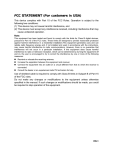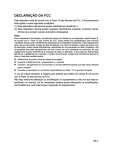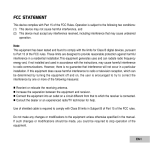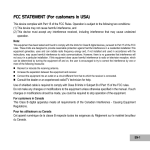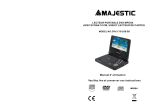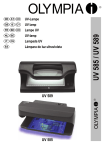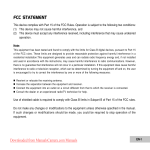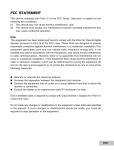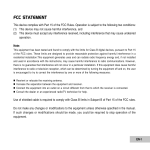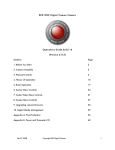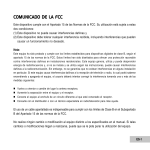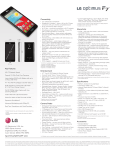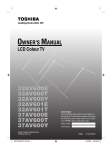Download Minox DC 6022 User Guide
Transcript
FCC STATEMENT (For customers in USA) This device complies with Part 15 of the FCC Rules. Operation is subject to the following two conditions: (1) This device may not cause harmful interference, and (2) This device must accept any interference received, including interference that may cause undesired operation. Note: This equipment has been tested and found to comply with the limits for Class B digital devices, pursuant to Part 15 of the FCC rules. These limits are designed to provide reasonable protection against harmful interference in a residential installation.This equipment generates uses and can radiate radio frequency energy and, if not installed and used in accordance with the instructions, may cause harmful interference to radio communications. However, there is no guarantee that interference will not occur in a particular installation. If this equipment does cause harmful interference to radio or television reception, which can be determined by turning the equipment off and on, the user is encouraged to try to correct the interference by one or more of the following measures: Reorient or relocate the receiving antenna. Increase the separation between the equipment and receiver. Connect the equipment into an outlet on a circuit different from that to which the receiver is connected. Consult the dealer or an experienced radio/TV technician for help. Use of shielded cable is required to comply with Class B limits in Subpart B of Part 15 of the FCC rules. Do not make any changes or modifications to the equipment unless otherwise specified in the manual. If such changes or modifications should be made, you could be required to stop operation of the equipment. EN-1 READ THIS FIRST Trademark Information Microsoft® and Windows® are U.S. registered trademarks of Microsoft Corporation. Pentium® is a registered trademark of Intel Corporation. Macintosh is a trademark of Apple Computer, Inc. SD™ is a trademark. Photo Explorer and Photo Express are trademarks. Other names and products may be trademarks or registered trademarks of their respective owners. Product Information Product design and specifications are subject to change without notice. This includes primary product specifications, software, software drivers, and user’s manual. This User Manual is a general reference guide for the product. The product and accessories that come with your digital camera may be different from those described in this manual. This is due to the fact that different retailers often specify slightly different product inclusions and accessories to suit their market requirements, customer demographics, and geographical preferences. Products very often vary between retailers especially with accessories such as batteries, chargers, AC adapters, memory cards, cables, carrying cases/pouches, and language support. Occasionally a retailer will specify a unique product color, appearance, and internal memory capacity. Contact your dealer for precise product definition and included accessories. The illustrations in this manual are for the purpose of explanation and may differ from the actual design of your digital camera. The manufacturer assumes no liability for any errors or discrepancies in this user manual. For user manual and driver updates, refer to our website or contact your dealer. EN-2 SAFETY INSTRUCTIONS Read and understand all Warnings and Cautions before using this product. Warnings If foreign objects or water have entered the camera, turn the power OFF and remove the batteries and the AC power adapter. Continued use in this state might cause fire or electric shock. Consult the store of purchase. If the camera has fallen or its case has been damaged, turn the power OFF and remove the batteries and the AC power adapter. Continued use in this state might cause fire or electric shock. Consult the store of purchase. Do not disassemble, change or repair the camera. This might cause fire or electric shock. For repair or internal inspection, ask the store of purchase. Use the supplied AC adapter only with the indicated power supply voltage. Use with any other power supply voltage might cause fire or electric shock. Do not use the camera in areas near water. This might cause fire or electric shock. Take special care during rain, snow, on the beach, or near the shore. Do not place the camera on inclined or unstable surfaces. This might cause the camera to fall or tilt over, causing injury. Keep the batteries out of the reach of children. Swallowing batteries might cause poisoning. If the battery is accidentally swallowed, immediately consult a physician. Do not use the camera while you are walking, driving or riding a motorcycle. This might cause you to fall over or result in traffic accident. EN-3 Cautions Insert the batteries paying careful attention to the polarity (+ or –) of the terminals. Inserting the batteries with their polarities inverted might cause fire and injury, or damage to the surrounding areas due to the battery rupturing or leaking. Do not fire the flash close to anyone’s eyes. This might cause damage to the person’s eyesight. Do not subject the LCD monitor to impact. This might damage the glass on the screen or cause the internal fluid to leak. If the internal fluid enters your eyes or comes into contact with your body or clothes, rinse with fresh water. If the internal fluid has entered your eyes, consult a physician to receive treatment. A camera is a precision instrument. Do not drop it, strike it or use excessive force when handling the camera. This might cause damage to the camera. Do not use the camera in humid, steamy, smoky, or dusty places. This might cause fire or electric shock. Do not remove the batteries immediately after long period of continuous use. The battery becomes hot during use. Touching a hot battery might cause burns. Do not wrap the camera or place it in cloth or blankets. This might cause heat to build up and deform the case, resulting in fire. Use the camera in a well-ventilated place. Do not leave the camera in places where the temperature may rise significantly, such as inside a car. This might adversely affect the case or the parts inside, resulting in fire. Before you move the camera, disconnect cords and cables. Failure to do this might damage cords and cables, resulting in fire and electric shock. EN-4 Notes on Battery Usage When you use the batteries, carefully read and strictly observe the Safety Instructions and the notes described below: Different battery types and surrounding temperatures may affect the battery performance. Avoid using batteries in extremely cold environments as low temperatures can shorten the battery life and reduce camera performance. This low temperature will also influence Alkaline battery performance, therefore Ni-MH rechargeable battery is highly recommended. If you are using the new rechargeable batteries or rechargeable batteries that have not been used for an extended period of time (batteries that pass the expiry date are exceptions) might affect the number of pictures that can be taken. Therefore, to maximize their performance and lifetime, we recommend that you fully charge the batteries and discharge them for at least one complete cycle before use. The batteries may feel warm when using the camera for an extended period of time or using the flash continuously. This is normal and not a malfunction. The camera may feel warm when being used continuously or for an extended period of time. This is normal and not a malfunction. If you will not be using the batteries for an extended period of time, remove them from the camera to prevent leakage or corrosion. Never use batteries of different types (together) or mix old and new batteries. Always keep the terminals clean. Never use manganese batteries. There is a risk of explosion if the batteries are replaced with an incorrect type. Dispose of used batteries according to the instructions. EN-5 Contents INTRODUCTION....................................................8 PHOTOGRAPHY MODE..................................... 25 Package Contents ................................................. 9 Shooting Images.................................................. 25 Setting Image Resolution and Quality ................. 26 Using the Zoom Function..................................... 27 Using the Flash.................................................... 28 Setting Focus....................................................... 29 GETTING TO KNOW YOUR CAMERA...............10 Front View............................................................ 10 Rear View ............................................................ 11 Mode Dial............................................................. 12 LCD Monitor Information...................................... 13 PREPARING THE CAMERA...............................16 Installing the Batteries ......................................... 16 Using the AC Adapter (Optional Accessory)........ 17 Inserting and Removing an SD Memory Card (Optional Accessory) ........................................... 18 Attaching the Camera Strap ................................ 19 GETTING STARTED ...........................................20 Turning the Power On/Off.................................... 20 Choosing the Screen Language .......................... 21 Setting the Date and Time ................................... 22 Formatting an SD Memory Card or Internal Memory................................................... 23 Using the LCD Monitor ........................................ 24 EN-6 Capture Mode..................................................... 30 Burst .................................................................... 30 Auto Bracket ........................................................ 31 Self-Timer ............................................................ 32 Adjusting the Exposure (EV Compensation) ....... 34 Setting White Balance ......................................... 35 USING THE MODE DIAL.................................... 36 Auto Mode [ ]................................................... 36 Program Mode [ ] ............................................ 36 Portrait Mode [ ] .............................................. 37 Landscape Mode [ ] ........................................ 37 Sport Mode [ ] ................................................. 38 Night Mode [ ].................................................. 38 PLAYBACK MODE - THE BASICS.................... 39 EDITING SOFTWARE INSTALLATION .............55 Viewing Images ................................................... 39 Magnifying Images .............................................. 40 Thumbnail Display............................................... 41 Slideshow Display ............................................... 42 Resizing an Image .............................................. 43 Installing Photo Explorer ..................................... 55 Installing Photo Express...................................... 56 MOVIE MODE ..................................................... 44 Recording Movie Clips ........................................ 44 Playing Back Movie Clips .................................... 45 PLAYBACK MODE - ADVANCED FEATURES. 46 Playing Back Still Images/Movie Clips on TV...... 46 Deleting Images/Movie Clips............................... 47 Protecting Images/Movie Clips............................ 48 Setting the DPOF ................................................ 49 TRANSFERRING FILES FROM YOUR DIGITAL CAMERA TO COMPUTER ................................. 51 Step 1: Install the USB driver .............................. 52 Step 2: Connect the digital camera to your computer ..................................................... 53 Step 3: Download images or movie clips ............ 54 USING THE DIGITAL CAMERA AS A PC CAMERA .............................................................57 Step 1: Install the PC camera driver ................... 57 Step 2: Connect the digital camera to your computer ..................................................... 58 Step 3: Run your application software (i.e. Windows NetMeeting) .................................. 59 MENU OPTIONS .................................................60 Camera Menu ..................................................... 60 Movie Menu......................................................... 65 Playback Menu.................................................... 66 Setup Menu......................................................... 69 CONNECTING THE DIGITAL CAMERA TO OTHER DEVICES................................................73 SPECIFICATIONS...............................................74 APPENDIX...........................................................76 EN-7 INTRODUCTION Thank you for purchasing the new digital still camera! Equipped with a 6.0 Megapixels CCD sensor, your camera delivers high quality, 2816 x 2112 resolution images. Other features provided by the camera include the following: 6.0 Megapixels A high-resolution CCD sensor provides 6.0 megapixels for high quality images. Auto flash An auto flash sensor automatically detects the shooting (lighting) conditions and determines whether the flash should be used. 2.4” TFT color image LCD monitor Optical zoom: 1x~3x Digital zoom: 1x~4x Approx. 11 MB internal (built-in) memory Images can be captured without using an SD memory card. Support for SD memory card for memory expansion You may wish to expand the memory capacity (up to 1GB) by using an optional SD memory card. EN-8 USB connection Still images or movie clips that you have recorded can be downloaded to your computer using the USB cable (A USB driver is required for Win 98 and Win98SE). DPOF functionality DPOF can be used to print your images on a DPOF compatible printer by simply inserting the SD memory card. Provided editing software: Photo Explorer/ Photo Express You can enhance and retouch your images on your computer by using the provided editing software. Package Contents Carefully unpack your kit box and ensure that you have the following items. In the event that any item is missing or if you find any mismatch or damage, promptly contact your dealer. Common Product Components: Digital Camera User's Manual Software CD-ROM Camera Strap Camera Pouch AV Cable USB Cable Batteries ******************************************************************************* Common (Optional) Accessories: AC power adapter SD memory card Accessories and components may vary by retailer. EN-9 GETTING TO KNOW YOUR CAMERA Front View 1 2 3 4 5 6 7 8 9 1. 2. 3. 4. 5. EN-10 Shutter release button Flash Power switch Mode dial Self-timer LED 6. 7. 8. 9. Microphone PC / AV terminal DC input terminal Lens Rear View 1 2 3 4 14 5 6 7 8 9 10 11 13 1. LED indicator 2. / Zoom in (telephoto) button / Zoom out (wide-angle) button 3. Playback button 4. Menu button 5. Delete button 6. Arrow button (Up) Self-timer button 7. Arrow button (Right) Focus button 12 8. Strap holder 9. Arrow button (Down) Exposure compensation button 10. Arrow button (Left) Flash button 11. button Display button 12. Battery / card cover 13. Tripod socket 14. LCD monitor EN-11 Mode Dial You can select from seven shooting modes and setup mode according to shooting conditions to achieve the desired effect. 8 7 1 2 6 3 5 4 Mode Description 1. Program Select this mode to permit the shutter speed and aperture to be set manually. 2. Portrait Select this mode to make people stand out with the background out-of-focus. 3. Landscape Select this mode to take photographs of distant scenery or landscapes. 4. Sports Select this mode to shoot fast moving objects. 5. Night Select this mode to take photographs of people against a dusk or night-time background. 6. Setup Select this mode to adjust the camera settings. 7. Video Select this mode to record video clips. 8. Auto Select this mode to adjust point-and-shoot action. EN-12 LCD Monitor Information 1 2 3 4 Camera Mode 1. Mode indication [ ] Program Mode [ ] Portrait Mode [ ] Landscape Mode [ ] Sport Mode [ ] Night Mode [ ] Setup Mode [ ] Movie Mode [ ] Auto Mode 2. Flash mode [ ] Auto [ ] Red eye [ ] Flash on [ ] Flash off 3. Capture mode [ ] Single [ ] Burst [ ] AEB [ ] 2 sec. Self-timer [ ] 10 sec. self-timer [ ] 10+2 sec. Self-timer 4. Focus mode [ ] Standard [ ] Macro [ ] Infinity 5. Possible number of shots 6. Memory status : Built-in memory (without card) : SD memory card 7. Battery and AC adapter [ ] Full battery power [ ] Medium battery power [ ] Low battery power [ ] No battery power [ ] AC adapter 8. Recorded pixels [ ] 2816 x 2112 [ ] 2272 x 1704 [ ] 1600 x 1200 [ ] 640 x 480 9. Image quality [ ] Fine [ ] Normal [ ] Economy 10. White balance Auto [ ] Daylight [ ] Cloudy [ ] Tungsten [ ] Fluorescent 5 6 3 7 8 9 10 2.2X 14 +0.3 11 12 13 11. ISO sensitivity [ ] Auto [ ] 64 [ ] 100 [ ] 200 12. EV compensation 13. Focus area 14. Zoom bar EN-13 1. 2. 3. 4. 5. 6. 7. Movie Mode 1 2 3 Movie mode Flash mode Recordable movie time available Memory status Battery power and AC adapter indicator Focus area Zoom bar 4 00:49 5 6 7 Image Playback 1. Playback mode 2. Number of image 3. Memory status 4. Battery power and AC adapter indicator 5. Index number of total number 6. DPOF indicator 7. Protect indicator 8. Date 9. Time 10. EV compensation 11. ISO sensitivity 12. White balance 13. Image quality 14. Recorded pixels EN-14 1 2 3 100-0001 1/7 14 13 12 11 ISO 100 10 +0.3 01/01/2006 12:00 4 5 6 7 8 9 Movie Playback 1. Playback mode 2. Movie mode 3. Number of movie 4. Memory status 5. Battery power and AC adapter indicator 6. Index number of total number 7. Elapsed time 8. Date 9. Time 10. Play/Pause indicator 1 2 3 4 100-0001 10 00:05 1/7 5 6 7 01/01/2006 12:01 8 9 EN-15 PREPARING THE CAMERA Installing the Batteries You can use 2 AA size batteries (alkaline or Ni-MH rechargeable) to power the camera. Make sure that the power of the digital camera is off before inserting or removing the batteries. 1. Make sure the camera is turned off. 2. Open the battery cover. 3. Insert the batteries in the correct orientation as shown in the illustration. 4. Close the battery cover. To remove the batteries, turn the camera off before removing batteries and hold the camera with the battery cover facing upward, then open the battery cover. Be careful not to drop the batteries when opening or closing the battery cover. Due to the characteristics of AA alkaline batteries, camera performance may deteriorate. AA alkaline batteries are not recommended except in emergencies and checking the camera's functionality. EN-16 Using the AC Adapter (Optional Accessory) Use of the AC adapter is recommended if you intend to use the LCD monitor for a long time or connect the camera to a PC. 1. Make sure your camera is off. 2. Connect one end of the AC adapter to the camera DC input terminal labeled "DC IN 3V". 3. Connect the other end to a power outlet. . Make sure to use only the AC adapter specified for the camera. Damage caused by the use of an incorrect adapter is not covered under the warranty. To prevent unexpected auto power off resulting from no battery power left during the process of transferring your images to the computer, use the AC adapter as a power supply. The AC adapter can only be used to power the camera. Batteries cannot be charged inside the camera. EN-17 Inserting and Removing an SD Memory Card (Optional Accessory) The digital camera comes with 11MB of internal memory, allowing you to store captured still images or video clips in the digital camera. Moreover, you can also expand the memory capacity by using an optional SD (Secure Digital) memory card so that you can store more files. 1. Make sure your camera is turned off before inserting or removing a memory card. 2. Open the battery/SD memory card cover. 3. Insert an SD memory card in the correct orientation as shown in the illustration. 4. Close the battery/SD memory card cover. To remove the SD memory card, make sure the camera is turned off. Press lightly on the edge of the memory card and it will eject. Be sure to format an SD memory card with this digital camera before using it. Refer to section in the manual titled “Formatting an SD Memory Card or Internal Memory” for further details. To prevent valuable data from being accidentally erased from an SD card, you can slide the write protect tab (on the side of the SD memory card) to “LOCK”. To save, edit, or erase data on an SD memory card, you must unlock the card. EN-18 Attaching the Camera Strap Attach the strap as shown in the illustration. EN-19 GETTING STARTED Turning the Power On/Off Press the power switch until the digital camera turns on. To turn the power off, press the power switch again. EN-20 Power switch Choosing the Screen Language Follow the steps below to choose the desired language. 1. Rotate the mode dial to the power switch. and turn your camera on by pressing 2. [Set-up1] is displayed. 3. Use the four-way controller (T) to select [Language], then press the button. 4. Use the four-way controller (ST) to select the language you want. 5. Press the button to confirm. Set-up1 Set-up2 Set-up3 Format Beeper Time te & Tim Date Langu Language Louder m/d/y Englis English lish En Select : EN-21 Setting the Date and Time Follow the steps below to set the date display style, current date and time. 1. Rotate the mode dial to and turn your camera on by pressing the power switch. 2. [Set-up1] is displayed. 3. Use the four-way controller (T) to select [Date & Time] and the four-way controller (WX) to switch the date types,then press the button. Set-up1 Set-up2 Set-up3 Format Beeper Louder Date te & Tim Time m/d/y Language Langu English Englis En lish Select : 4. Press the four-way controller (WX) to select Day, Month, Year and Time fields. To increase a value, press the four-way controller (S). To decrease a value, press the four-way controller (T). The time is displayed in 24-hour format. 5. Press the button after all fields are set. Date te & Tim Time 01 / 01 / 2006 00 : 00 Cancel : Select : The date illustration shown is for the purpose of explanation and may differ from the actual setting of your camera. EN-22 Formatting an SD Memory Card or Internal Memory The term “Formatting” means preparing an “SD memory card” to record images; this process is also called “initialization”. This utility formats an SD memory card or the internal memory and erases all stored images and data. 1. Rotate the mode dial to and turn your camera on by pressing the power switch. [Set-up1] is displayed. 2. Use the four-way controller (T) to select [Format], then press the button. Set-up1 Set-up2 Set-up3 Format Beeper Louder Time te & Tim Date Language Langu m/d/y Englis English lish En Select : 3. Use the four-way controller (ST) to select [Yes], then press the button to confirm. Format Yes No Select : When you format an SD memory card, be aware that all data on the SD memory card will be erased. Protected images are also erased. To format the internal memory, do not insert an SD memory card into the camera. Otherwise, you will format the SD memory card. An SD memory card having any problem cannot be properly formatted. EN-23 Using the LCD Monitor Your camera is equipped with a 2.4” full color TFT LCD monitor to help you compose images, replay recorded images/movie clips or adjust menu settings. The mode icons, text and numbers displayed on the monitor may vary according to the current settings. 1. 2. 3. 4. Rotate the mode dial to , , , , , or Press the power switch to turn on the power. Compose your scene on the LCD monitor. Press the shutter release button. . The LCD monitor darkens in strong sunlight or bright light. This is not a malfunction. To prevent your images from being blurred while pressing the shutter release button, always hold it carefully. This is especially important when you are shooting under low lighting conditions, since your camera may decelerate the shutter speed to ensure your images are properly exposed. EN-24 PHOTOGRAPHY MODE Shooting Images 1. Rotate the mode dial to , , , , , or and turn your camera on by pressing the power switch. 2. Compose the image on the LCD monitor screen so that the main subject is within the focus frame. 3. Press the shutter release button down halfway to focus the image. When you press the shutter release button down halfway, the camera’s Auto Focus feature automatically focuses the image. The focus frame turns green if the subject is in focus. Proper exposure is determined and locked at the same time. 4. Press the shutter release button the rest of the way down to capture the image. The actual captured image appears to be larger than the one displayed by the LCD monitor screen after the image has been captured. Pressing the / button switches the LCD monitor display mode. Each time you press the / button, the display changes in the following order: Normal Display Æ Infomation Display Æ No Icons Æ LCD Off. EN-25 Setting Image Resolution and Quality As you get to know the digital camera, you can set the image resolution (number of vertical and horizontal pixels) and image quality (compression ratio) based on the types of images you want to shoot.These settings affect the number of images that can be stored in the internal memory, or on an SD memory card. Higher resolution and higher quality images provide finer detail but cause the images’ file size to be larger. To change image resolution or image quality, perform these steps below: 1. Rotate the mode dial to , , , , , or and turn your camera on by pressing the power switch. 2. Press the button. [Mode1] is displayed. In the mode, [Auto] is displayed. 3. Use the four-way controller (T) to select [Image Size], then press the button. 4. Use the four-way controller (ST) to select the desired setting, then press the button to confirm. 5. Follow the step 3 and 4 above to set the [Quality]. Mode1 Mode2 Mode3 Image Im ge Size Si Quality W.. Balance Balanc ISO Return eturn n: Retu Select : Image Im ge Size Si 2816 X 2112 2272 X 1704 1600 X 1200 The possible number of shots and recording time depend on the storage size, resolution and quality settings and the subject of the image to be captured. You can resize the images later. Please refer to the section in this manual titled “Resizing an Image” (EN-43) for further detail. EN-26 640 X 480 Cancel : Select : Using the Zoom Function This camera is equipped with 3x optical zoom. The lens moves during the optical zoom photography, allowing you to capture telephoto and wide-angle shots. By using the optical zoom function; images appear closer by pressing the button, or smaller away by pressing the button. The zoom bar indicates the current level of magnification. When the 3 digital zoom is within 3x magnification, the zoom bar is within the optical zoom range. When the digital zoom function is set to On, you can further enlarge the subjects with 4x digital zoom by continuing to press the button. It is activated after your camera reaches its maximum optical zoom factor (3x) and the zoom bar is within the digital zoom area. You can enlarge the subject to a maximum 2.2X magnification equivalent to 12 times. A useful feature as it is, however, the more the image is enlarged, the more pixelated the Optical zoom range Digital zoom range image will appear. Zoom bar To capture a zoomed image, perform the following steps: 1. Rotate the mode dial to , , , , , or and turn your camera on by pressing the power switch. 2. Adjust the magnification ratio by using the / button. To exit the zoom photography, press and hold the button. The status of digital magnification is displayed on the LCD monitor. 3. Compose your scene and press the shutter release button. To enable the digital zoom feature, set the [Mode2- Digital Zoom] to [On] in the (Refer to EN-63 for further details). , , , , , or mode. EN-27 Using the Flash The flash is designed to function automatically when lighting conditions warrant the use of flash. You can take an image using a desired flash mode to suit your circumstances. 1. Rotate the mode dial to , , , , , or . 2. Press the power switch to turn on the power. 3. Press the four-way controller (W/ ). The flash mode changes each time the button is pressed. You can also change the setting using the four-way controller (ST). 4. Press the button to confirm the setting. 5. Compose your scene and press the shutter release button. Flash lash Mode Mod Aut Auto uto OK : The camera has four flash modes: Auto, Red-eye, Flash on and Flash off. The table below will help you to choose the appropriate flash mode: Flash mode EN-28 Description Auto The flash fires automatically according to the photographic conditions. Red-eye Use this mode to reduce the red-eye phenomenon when you want to take natural-looking photographs of people and animals in low-light conditions.When taking photographs, the red-eye phenomenon can be reduced by asking the subject (person) to look at the digital camera or get as close to the digital camera as possible. Flash on The flash will always fire regardless of the surrounding brightness. Flash off The flash will not discharge, regardless of the brightness. Use this mode when taking pictures using indoor lighting, for stages and indoor competitions, and when the subject is too far away for the flash to be effective. Setting Focus Images can be captured with the focus determined automatically using auto focus. You may over-ride the auto focus and specify [ ] macro or [ ] infinity. 1. Rotate the mode dial to , , , , , or . 2. Press the power switch to turn on the power. 3. Press the four-way controller (X/ ). The focus mode changes each time the button is pressed. You can also change the setting using four-way controller (ST). 4. Press the button to confirm the setting. 5. Compose your scene and press the shutter release button. The camera has three focus modes: Standard, Macro and Infinity. The table below will help you choose the appropriate focus mode: Focus mode Focu Focus ocus Standard Standa OK : Description Standard Select Standard-focus setting for most occasions when you want the camera to automatically determine the focus setting.When using Standard-focus setting, any object at a range of focus is 40 cm or greater can be in focus. Macro Select Macro-focus setting to capture close-up images. When the lens is zoomed to its widest position you may focus on objects as close as 5 cm.When the lens is zoomed to its telephoto position (3x zoom) you may focus on objects as close as 30 cm. Infinity Select Infinity-focus setting when you want to capture an image of a subject at infinity. The flash mode will be set to Flash Off automatically. EN-29 Capture Mode Burst This mode is used for continuous shooting. 3 pictures are taken continuously once the shutter release button is pressed. Secure the camera to a tripod or place it on a stable surface. 1. Rotate the mode dial to , , , , , or . 2. Press the power switch to turn on the power. 3. Press the four-way controller (S/ ) and use (S) to select [Burst]. You can also change the setting using four-way controller (WX). 4. Press the button to confirm the setting. The indicator is displayed on the monitor screen. 5. Press the shutter release button halfway to lock the focus. 6. Press the shutter release button to capture a sequence of images. In Burst mode, the flash mode will be set to Flash Off automatically. EN-30 Capture Captu pture e Mod Mode Burst Bu OK : Auto Bracket In this mode, the camera automatically changes the exposure within a set range to take three shots after you press the shutter release button once. Auto Bracket settings can be combined with exposure compensation settings to extend the adjustment range. 1. Rotate the mode dial to , , , , , or . 2. Press the power switch to turn on the power. 3. Press the four-way controller (S/ ) and use (S) to select [AEB]. You can also change the setting using the four-way controller (WX). 4. Press the button to confirm the setting. The indicator is displayed on the LCD monitor screen. 5. Press the shutter release button to capture the three images. Capture Mode Captu pture e Mod AEB OK : In AEB mode, the flash mode will be set to Flash Off automatically. EN-31 Self-Timer The self-timer can be used in situations such as group shots. When using this option, you should either mount the camera on a tripod (recommended) or rest it on a flat, level surface. 1. 2. 3. 4. Secure the camera to a tripod or place it on a stable surface. Rotate the mode dial to , , , , , or . Press the power switch to turn on the power. Press the four-way controller (S/ ) and use (S) to select your desired self-timer mode. You can also change the setting using four-way controller (WX). 5. Press the button to confirm the setting. 6. Compose your scene and press the shutter release button. The self-timer function is activated. The photograph is then taken after the preset time. To cancel the self-timer at any time, press the four-way controller (S/ ) or press the shutter release button halfway. EN-32 Captu Capture pture e Mod Mode 2 sec. Self-timer OK : The table below will help you choose the appropriate self-timer mode: Self-timer mode Description 2 sec. Self-timer The image is captured about 2 seconds after the shutter is pressed. This mode is useful for preventing camera shake. 10 sec. Self-timer The image is captured about 10 seconds after the shutter is pressed. This mode is suitable for the shots in which the photographer has to be included. 10+2 sec. Self-timer The first image is captured about 10 seconds after the shutter release button is pressed, and then the second image is captured 2 seconds later. This mode is convenient when capturing group images in succession. Flash does not fire in this mode. After one shot is taken, the self-timer mode is turned off. If you wish to take another image using the self-timer, repeat these steps. EN-33 Adjusting the Exposure (EV Compensation) You can manually adjust the exposure determined by the digital camera. Use this mode when the proper exposure cannot be obtained, for example, when the contrast (difference between bright and dark areas) between the subject and the background is extremely high. The EV compensation value can be set from -2.0EV to +2.0EV. 1. Rotate the mode dial to , , , , or . 2. Press the power switch to turn on the power. 3. Press the four-way controller (T/ ) and use WX to set the range of EV compensation value from -2.0EV to +2.0EV. 4. Press the button to confirm the setting. EV ±0.0 0.0 Select : EN-34 Set : Setting White Balance This feature lets you make adjustments to compensate for different lighting types according to your shooting conditions. 1. 2. 3. 4. Rotate the mode dial to , , , , or . Press the power switch to turn on the power. Press the button. [Mode1] is displayed. Use the four-way controller (T) to select [W. Balance], then press the button. 5. Use the four-way controller (ST) to select the desired white balance setting, then press the button to confirm. 6. To cancel the setting, press the button and exit the menu. Mode1 Mode2 Mode3 Image Im ge Size Si Quality W.. Balance Balanc ISO Return eturn n: Retu Select : W.. Balance Balanc Auto uto Aut Daylight Cloudy Tungste Tungsten ungsten Cancel : Select : W.. Balanc Balance Fluo Fluorescent luorescen escent Cancel : Select : EN-35 USING THE MODE DIAL Auto Mode [ ] (Auto) mode is the simplest way which allows you to take still pictures without having to set special functions or manual adjustments. The camera sets the optimal focusing and exposure. 1. Rotate the mode dial to and turn your camera on by pressing the power switch. 2. Compose your subject within the focus frame. 3. Press the shutter release button down halfway to focus the image. When you press the shutter release button down halfway, the camera’s Auto Focus feature automatically focuses the image. Proper exposure is determined and locked at the same time. 4. Press the shutter release button the rest of the way down to capture the image. Program Mode [ ] In the (Program) mode, the camera automatically sets the shutter speed and aperture for taking still images. You can adjust other functions, such as flash mode or continuous shooting mode. 1. Rotate the mode dial to and turn your camera on by pressing the power switch. 2. Compose your subject within the focus frame. 3. Press the shutter release button to capture the image. EN-36 Portrait Mode [ ] Select this mode to make people stand out with the background out-of-focus. 1. Rotate the mode dial to and turn your camera on by pressing the power switch. 2. Compose your subject within the focus frame. 3. Press the shutter release button to capture the image. Landscape Mode [ ] This mode allows you to take photographs of distant scenery or landscapes. 1. Rotate the mode dial to and turn your camera on by pressing the power switch. 2. Compose your subject within the focus frame. 3. Press the shutter release button to capture the image. EN-37 Sport Mode [ ] This mode allows you to shoot fast moving objects. 1. Rotate the mode dial to and turn your camera on by pressing the power switch. 2. Compose your subject within the focus frame. 3. Press the shutter release button to capture the image. Night Mode [ ] This mode allows you to take photographs of people against a dusk or night-time background. 1. Rotate the mode dial to and turn your camera on by pressing the power switch. 2. Compose your subject within the focus frame. 3. Press the shutter release button to capture the image. EN-38 PLAYBACK MODE - THE BASICS Viewing Images You can display the still images one by one. 1. Rotate the mode dial to , , , , , or and turn your camera on by pressing the power switch. 2. Press the button. The last recorded image appears on the LCD monitor screen. Basic information is shown by indicators on the LCD monitor screen. To see full information display, press the / button. 3. Use the four-way controller (WX) to select the desired images. To view the previous image, press the four-way controller (W). To view the next image, press the four-way controller (X). 100-0001 For protected images/movie clips, mark will be displayed. Refer to the section in this manual titled “Protecting Images/Movie Clips” (EN-48) for further details. For images selected for printing with DPOF setting, mark will be displayed. (Refer to the section in this manual titled “Setting the DPOF” (EN-49, 50) for further details.) If there is no image stored in the internal memory or on the SD memory card, [No image] message will appear on the LCD monitor screen. You cannot enter the Playback mode from the Setup mode. EN-39 Magnifying Images While reviewing your images, you may enlarge a selected portion of an image. This magnification allows you to view fine details. The zoom factor displayed on the screen shows the current magnification ratio. 1. Press the button. The last recorded image appears on the LCD monitor screen. To view the previous image, press the four-way controller (W). To view the next image, press the four-way controller (X). 2. Adjust the zoom ratio by using the / button. To enlarge the selected image, press the button. To return to the normal image, press the button. The magnification factor is displayed on the LCD monitor screen. 3. To view different portions of the images, press the four-way controller (STWX) to adjust the display area. The magnification factors range from 1.5X to 4X (within 6 stages: 1.5X, 2.0X, 2.5X, 3.0X, 3.5X and 4.0X). EN-40 1.5X Thumbnail Display This function allows you to view 9 thumbnail images on the LCD monitor screen simultaneously so you may search for a particular image. 1. Press the button. The last recorded image appears on the LCD monitor screen. 2. Press the / button once. Nine thumbnail images are displayed simultaneously. For recorded movie clips, the movie mode icon will be displayed. For protected images/movie clips, mark will be displayed. (Refer to the section in this manual titled “Protecting Images/ Movie Clips” (EN-48) for further details.) 3. Use the four-way controller (STWX) to move the cursor to select the image to be displayed at regular size. 4. Press the or / button to display the selected image on full screen. 1 2 3 4 5 6 7 8 9 EN-41 Slideshow Display The slideshow function enables you to play your images back automatically in sequential order. This is very useful and entertaining feature for reviewing recorded images and for presentations. 1. Press the button. The last recorded image appears on the LCD monitor screen. 2. Press the button to access the Playback menu. Then use the four-way controller (T) to select [Slide Show] and press the button. Playba Playback1 Protec otect Protect DPOF Select : Return Retu eturn n: 3. Use the four-way controller (ST) to set the playback interval, then press the button. The slideshow starts. The movie clips display the first frame image, and the movie is not played back. To stop slideshow, press the button. Slide Show Sh 3 Sec. 5 Sec. 10 Sec. Cancel : You can adjust the slideshow display interval within the range of 3 sec., 5 sec., 10 sec.. EN-42 Playba Playback2 Slide Show Sh Startt : Sta Resizing an Image You can change the image size of a captured image to one of the following sizes: 2272 x 1704 pixel, 1600 x 1200 pixel and 640 x 480 pixel. 1. Press the button. The last recorded image appears on the LCD monitor screen. 2. In the mode, use the four-way controller (WX) to select the desired images. To view the previous image, press the four-way controller (W). To view the next image, press the four-way controller (X). 3. Press the button to access the Playback menu. Press the four-way controller (X) to select [Playback2] and press (T) to select [Resize] and press the button. 4. Use the four-way controller (ST) to select the desired setting, then press the button to confirm. Playba Playback1 Playback2 Playba Resi Resize esize Quality Change Co y To Copy o Card Ca Select : Retu Return eturn n: Resize Resi esize 2272 X 1704 1600 X 1200 640 X 480 Cancel : Select : You can only choose a smaller size image; you cannot increase the resolution of an image. Movie cannot be resized. EN-43 MOVIE MODE Recording Movie Clips This mode allows you to record movie clips with sound via built-in microphone. 1. Rotate the mode dial to and turn your camera on by pressing the power switch. 2. Press the shutter release button to start recording. 3. To stop recording, press the shutter release button again. 00:49 The optical zoom function (3X) can be activated before you start recording the movie clips The digital zoom function can be activated before and during the recording. Pressing the / button switches the LCD monitor screen display mode. Each time you press the display changes in the following order: Normal Display Æ No Icons Æ LCD Off. EN-44 / button, the Playing Back Movie Clips You can play back the recorded movie clips on the LCD monitor screen. However, the sound recorded with movie clips can only be played back on a TV or on a computer. 1. Press the button. 2. Use the four-way controller (WX) to go through the images until the movie clip you want to play back is displayed. To view the previous image, press the four-way controller (W). To view the next image, press the four-way controller (X). 3. Press the button to start playing back the movie clips. To pause or resume movie playback, press the button again. 100-0001 00:05 1/7 01/01/2006 12:01 The index number, date and time indicators displayed on the LCD monitor screen will disappear after a few seconds. The zoom function cannot be activated when playing back movie clips. To playback the movie clips on the computer, we recommend you to use Windows Media Player 9.0 or later (WMP 9.0 or later). You can download WMP version from the website at www.microsoft.com. EN-45 PLAYBACK MODE - ADVANCED FEATURES Playing Back Still Images/Movie Clips on TV You can also playback your images on a TV screen. Before connecting to any device, make sure to select NTSC/PAL system to match the video output system of the video equipment you are going to connect to the digital camera, then turn off all devices to be connected. 1. Connect one end of the AV cable to the AV terminal of the digital camera. 2. Connect the other end to the AV input socket of the TV set. 3. Turn the TV and digital camera on. 4. Playback the images/movie clips. The method of operation is the same as playing back still images and movie clips on the digital camera. The sound recorded with movie clips can only be played back on a TV or on a computer. EN-46 PC/AV terminal Deleting Images/Movie Clips Use this function to delete one or all images/movie clips stored in SD memory card or the internal memory. Please note that the deleted images or movie clips cannot be recovered. Exercise caution before deleting a file. 1. Rotate the mode dial to , , , , , or and turn your camera on by pressing the power switch. 2. Press the button. The last recorded image/movie clip appears on the LCD monitor screen. 3. Use the four-way controller (WX) to select the image/movie clip you want to delete. 4. Press the button to delete. 5. Use the four-way controller (ST) to select [This Image] or [All Images] by your preference, then press the button. 6. When the delete message appears, use the four-way controller (ST) to select [Yes], then press the button to confirm the deletion. If you wish to cancel the deletion, select [No]. Delete This his Image Im All Images Im Image ges Select : Cancel : Delete Yes No Select : Protected images cannot be deleted with the delete function. EN-47 Protecting Images/Movie Clips Set the data to read-only to prevent images from being erased by mistake. 1. Press the button. The last recorded image appears on the LCD monitor screen. 2. In the mode, use the four-way controller (WX) to select the desired images. To view the previous image, press the four-way controller (W). To view the next image, press the four-way controller (X). 3. Press the button, then use the four-way controller(T) to select [Protect] and press the button. 4. Use the four-way controller (ST) to choose the desired setting, then press the button. [Protect One]: Protect one image/movie. [Protect All]: Protect all images/movies (at once). Playba Playback1 Protect DPOF Select : Return Retu eturn n: Protect Protec otect Protect otect On One Protect otect Al All Select : Cancel : 5. Use the four-way controller (ST) to select [Lock], then press the button to confirm. Press the button to return to the mode. The indicator appears on the selected image. If you wish to cancel the protect function of a protected image, select [Unlock]. Protect otect One On Lo Lock Unlo Unlock Cancel : EN-48 Playba Playback2 Slide Show Sh Select : Setting the DPOF DPOF (Digital Print Order Format) allows you to embed printing information on your SD memory card. By using DPOF, you can select an image to be printed and then specify how many prints or which image you would like. Take your SD memory card to a DPOF enabled printer that accepts SD memory cards. The DPOF/card-compatible printer will read the embedded information on the SD memory card and print your images as specified. To configure print settings for a single image / all images. 1. Press the button, then use the four-way controller (WX) to select the desired image you want to print. 2. Press the button. Use the four-way controller (ST) to select [DPOF], then press the button. 100-0001 Playback1 Playba Playba Playback2 Slide Show Sh Protec Protect otect DPOF Select : Return Retu eturn n: 3. Use the four-way controller (ST) to select by your preference, then press the button. [One Image]: To configure print settings for a single image. [All Images]: To configure print settings for all images. [Reset All]: Resets all DPOF settings. DPOF One Im Image All Images Image ges Im Reset eset Al All Cancel : Select : EN-49 4. Use the four-way controller (ST) to select by your preference, then press the button. [Quantity]: Allows you to select image quantity (0~10). Use the four-way controller (WX) to set the image quantity. [Date]: The date of recording can be printed directly on the images. Select [Yes] or [No] with the four-way controller (WX). 5. Press the button to return to the image playback mode. The print icon is marked on the displayed image. To cancel the DPOF settings for a single image, go back to step 3 to select [One Image] and select 0 in [Quantity] in the next step. For resetting all the DPOF settings, go back to step 3 to select [Reset All]. One Image Im Quantity 1 Date Yes Cancel : Select : One Image Im Quantity 0 Yes Date Cancel : Select : 100-0001 Before you perform the DPOF settings on your camera, always remember to copy your images from the internal memory to an SD memory card first. The print icon will appear on the LCD monitor screen indicating images selected for printing. You cannot print movies. Depending on the printer or printing equipment at the photo processing lab., the date may not be imprinted on the pictures even if the DPOF settings are made. DPOF One Im Image All Images Image ges Im Reset eset Al All Cancel : EN-50 Select : TRANSFERRING FILES FROM YOUR DIGITAL CAMERA TO COMPUTER After using USB cable to establish a USB connection between the camera and your computer, you can use your computer to share recorded images or video clips with your family or friends via e-mail or post them on the Web. In order to do this, you must install the USB driver onto your computer first. Note that before you begin to install the software, you need to check your system according to the table as shown below. System Requirements (Windows) System Requirements (Macintosh) CPU Pentium III 600 MHz processor or higher PowerPC G3/G4 Operating System Windows 98SE/Me/NT/2000/XP OS 9.0 or higher RAM 32MB (64MB RAM recommended) 32MB (64MB RAM recommended) Hard Disk Space 128MB hard disk space 128MB hard disk space Required Devices A CD-ROM drive An available USB port An available USB port Display Color Monitor (800x600, 24-bit or higher recommended) Color Monitor (800x600, 24-bit or higher recommended) EN-51 Step 1: Install the USB driver Installation on Windows 98 & 98SE The USB driver on the supplied CD-ROM is exclusively for Windows 98 and 98SE. Windows 2000/ME/XP users need not install the USB driver. 1. Insert the enclosed CD-ROM into your CD-ROM drive. 2. When the welcome screen appears, click “Install USB/PC-Cam driver”. Follow the on-screen instructions to complete the installation. 3. After the USB driver has been installed, restart your computer. Installation on MAC OS 9.0 For Mac OS 9.0 or higher, the computer will automatically recognize the digital camera and load its own USB drivers. EN-52 Step 2: Connect the digital camera to your computer 1. Rotate the mode dial to and turn your camera on by pressing the power switch. 2. Press the four-way controller (X) to select the [Set-up2] menu, then use the four-way controller (T) to select [USB Mode]. 3. Press the button. Set-up1 Set-up2 USB Mode TV Set-up3 PC NTSC CD Brightness LCD Brightnes Auto uto Shut D Down 3 Min. Select : 4. Use the four-way controller (T) to select [PC], then press the button. 5. Turn off your camera. USB Mode PC PC CAM. Cancel : 6. Connect your camera and the computer via the supplied USB cable. 7. Turn your camera on by pressing the power switch. 8. There will be a new “Removable Disk” icon detected in “My Computer”, which contains your recorded images or movie clips. (For Mac users, double-click [untitled] or [unlabeled] disk drive icon on our desktop.) Select : PC/AV terminal EN-53 Step 3: Download images or movie clips When the digital camera is turned on and connected to your computer, it is considered to be a disk drive, just like a floppy disk or CD. You can download (transfer) images by copying them from the “Removable disk” (“untitled” or “unlabeled” disk on a Macintosh) to your computer hard drive. Windows Open the “removable disk” and double click on the DCIM / DSCIM folder to open it to find more folders. Your images are inside these folder(s). Select the desired still images or video clips and then choose “Copy” from the “Edit” menu. Open the destination location (folder) and choose “Paste” from the “Edit” menu. You may also drag and drop image files from the digital camera to a desired location. Macintosh Open the “untitled” disk icon, and the destination location on your hard disk. Drag and drop from the digital camera to the desired destination. Memory card users may prefer to use a memory card reader (highly recommended). Video playback application is not included with the package. Make sure that video playback application has been installed in your computer. EN-54 EDITING SOFTWARE INSTALLATION Installing Photo Explorer Ulead® Photo Explorer provides a simple and efficient way to transfer, browse, modify and distribute digital media. Acquire photos, video or sound clips from various digital device types and easily browse or add personal descriptions; make timely modifications; or distribute the media through the medium of your choice: E-mail, Print, Slideshow Presentations. It is an indispensable all-in-one tool for owners of digital cameras, WebCams, DV camcorders, scanners, or anyone who strives to effectively organize a large collection of digital media. 1. Insert the enclosed CD-ROM into your CD-ROM drive. 2. When the welcome screen appears, click “Install Ulead® Photo Explorer”. Follow the on-screen instructions to complete the installation. For more information about the operation of Photo Explorer application software, refer to its respective help documentation. For Windows 2000/XP users, please make sure to install and use the Photo Explorer in “Administrator” mode. Photo Explorer is not supported on the Mac. iPhoto or iPhoto2 is recommended. EN-55 Installing Photo Express Ulead® Photo Express is complete photo project software for digital images. The step-by-step workflow, visual program interface, and in-program help assist users in creating exciting photo projects. Acquire digital photos effortlessly from digital cameras or scanners. Organize them conveniently with the Visual Browse mode. Use hundreds of ready-to-use templates such as albums, cards, posters, slideshows, and more. Edit and enhance images with photo editing tools, photographic filters, and special effects. Embellish projects by adding creative design elements such as frames, callouts, and stamp objects. Share results with family and friends via e-mail and multiple print options. 1. Insert the enclosed CD-ROM into your CD-ROM drive. 2. When the welcome screen appears,click “Install Ulead® Photo Express”. Follow the on-screen instructions to complete the installation. For information on how to use Photo Express to edit and retouch your recorded images, please refer to its online help. For Windows 2000/XP users, make sure to install and use the Photo Express while logged in as a user with an Administrator account. Photo Express is not supported on the Mac. EN-56 USING THE DIGITAL CAMERA AS A PC CAMERA Your digital camera can act as a PC camera, which allows you to videoconference with business associates, or have a real-time conversation with friends or family. To use the digital camera for videoconferencing, your computer system must include the items as below: Microphone Sound card Speakers or headphones Network or Internet connection Video conferencing (or video editing) software is not included with the digital camera. This mode is not supported for Mac. Step 1: Install the PC camera driver The PC-camera driver included in the CD-ROM is exclusively for Windows. The PC camera function is not supported for Mac platforms. 1. Insert the enclosed CD-ROM into your CD-ROM drive. 2. When the welcome screen appears, click “ Install USB/PC-Cam driver ”. Follow the on-screen instructions to complete the installation. 3. After the driver installation is completed, restart your computer. EN-57 Step 2: Connect the digital camera to your computer 1. Rotate the mode dial to and turn your camera on by pressing the power switch. 2. Press the four-way controller (X) to select the [Set-up2] menu, then use the four-way controller (T) to select [USB Con.]. 3. Press the button. 4. Use the four-way controller (ST) to select [PC CAM], then press the button. 5. Connect your camera and the computer via the supplied USB cable. 6. Position the digital camera steadily on top of your computer monitor or use a tripod. EN-58 USB Mode PC PC CAM. Cancel : Select : Step 3: Run your application software (i.e. Windows NetMeeting) To use Windows NetMeeting for videoconferencing: 1. Go to Start Æ Programs Æ Accessories Æ Communications Æ NetMeeting to launch the NetMeeting program. 2. Click the Start Video button to view live video. 3. Click the Place Call button. 4. Type the e-mail address or the network address of the computer that you are calling. 5. Click Call. The person that you are calling must also have Windows NetMeeting running and be willing to accept your call to start the videoconference. The video resolution for videoconferencing applications is generally 320 x 240. For more information about the operation of videoconference application software, refer to its respective help documentation. Use of AC adapter is recommended while the camera is used as a PC camera. EN-59 MENU OPTIONS Camera Menu This menu is for the basic settings to be used when capturing still images. Auto Aut uto Mode1 Mode2 Mode3 Mode1 Mode2 Mode3 Mode1 Mode2 Mode3 Color Image Im ge Si Size Image Im ge Size Si Metering Quality Quality Digital Zoom On Sharpness Sha pness Sharpnes Medium W.. Balance Balanc Quick Qui k View Vie iew Off Saturation Satu turatio tion Medium ISO Return eturn n: Retu Select : eturn n: Retu Return Date te Imprin Imprint Return eturn n: Retu Off Retu Return eturn n: 1. Rotate the mode dial to , , , , , or and turn your camera on. 2. Press the button, then use the four-way controller (WX) to select the [Mode1] / [Mode2] / [Mode3] menu. In Mode, press the button to access the [Auto] menu directly. 3. Use the four-way controller (ST) to select the option item, then press the button. 4. Press the four-way controller (ST) to select the desired setting, then press the button. EN-60 In the Mode Item Functional Description Image Size Sets the size of the image that will be captured. Refer to the section in this manual titled "Setting Image Resolution and Quality" (EN-26) for further details. 2816x2112 2272x1704 1600x1200 640x480 Quality Sets the quality (compression rate) at which the image is captured. Refer to the section in this manual titled "Setting Image Resolution and Quality" (EN-26) for further details. Fine Normal Economy EN-61 In the , , , Mode1 settings , or Mode. Item Functional Description Image Size Refer to the section in this manual titled “Setting Image Resolution and Quality” (EN-26) for further details. Quality Refer to the section in this manual titled “Setting Image Resolution and Quality” (EN-26) for further details. W.Balance Sets the white balance when shooting under a variety of lighting conditions and permits photographs to be taken that approach the conditions that are seen by the human eye. Auto Daylight Cloudy Tungsten Fluorescent ISO Sets the sensitivity for taking pictures. When the sensitivity is raised (and the ISO figure is increased), photography will become possible even in dark locations, but the more pixelated (grainier) the image will appear. Auto / 64 / 100 / 200 EN-62 Mode2 settings Item Functional Description Metering You can select the metering mode that sets which part of the subject to measure to determine the exposure. Center-weighted: Averages the light metered from the entire frame, but gives greater wieght to the subject matter at the center. Spot: The exposure is determined by the small area in the center of the screen only. Digital Zoom This sets whether or not to use digital zoom at the time of shooting. Refer to the section in this manual titled “Using the Zoom Function” (EN-27) for further details. Quick View Set to display a photographed image on LCD monitor screen immediately after you have taken the shot. EN-63 Mode3 settings Item Functional Description Color Sets the color of the image that will be captured. Full Color Black & White Sepia Sharpness Sets the level of image sharpness. High Medium Low Saturation To capture an image, your camera offers you three different degrees of color to match with your preference. Your images will demonstrate different impression by selecting different degrees of color. This is called “Saturation”. High Medium Low Date Imprint The date of recording can be printed directly on the still images. This function must be activated before the image is captured. The date appears on the right bottom of the captured picture. When images are shot with date imprint feature, the date cannot be removed later. EN-64 Movie Menu This menu is for the basic settings to be used when recording movie clips. Video Vide ideo Color Digital Zoom Return Retu eturn n: 1. 2. 3. 4. 5. On Select : Rotate the mode dial to and turn your camera on. Press the button. Press the four-way controller (ST) to select the option item. Then press the button Press the four-way controller (ST) to select the desired setting, then press the button. To exit the movie menu, press the button. Item Functional Description Color Refer to the Camera Menu's option item (the details. (EN-64) , , , , or Mode) for further Digital Zoom Refer to the Camera Menu's option item (the details. (EN-63) , , , , or Mode) for further EN-65 Playback Menu In the menu, set the settings used for playback. Playba Playback1 Playba Playback2 Playba Playback1 Playback2 Playba Slide Show Sh Resi Resize esize Protec otect Protect Quality Change DPOF Co y To Copy o Card Ca Return Retu eturn n: Select : Retu Return eturn n: Select : 1. Press the button. The last recorded image appears on the LCD monitor screen. 2. Press the button, then use the four-way controller (ST) to select the [Playback1] / [Playback2] menu. 3. Use the four-way controller (ST) to select the option item, then press the button. 4. Press the four-way controller (ST) to select the desired setting, then press the button. 5. To exit the playback menu, press the button. EN-66 Playback1 Item Functional Description Slide Show You can play back recorded images in order with a selected interval time. This function is useful for checking your images or for presentations, etc. Refer to the section in this manual titled “Slideshow Display” (EN-42) for further details. 3 Sec. / 5 Sec. / 10 Sec. Protect Set the data to read-only to prevent images from being erased by mistake. Refer to the section in this manual titled “Protecting Images/Movie Clips” (EN-48) for further details. DPOF Allows you to select the desired pictures to be printed and set the number of prints and whether or not to imprint the data in DPOF format. You can print images easily just by inserting the SD memory card to a DPOF-compatible printer or taking it to a print shop. Refer to the section in this manual titled “Setting the DPOF” (EN-49) for further details. EN-67 Playback2 Item Functional Description Resize Changes the size of a recorded image. Resizing replaces the original image with the changed image. Only resizing to a smaller size is available. Refer to the section in this manual titled “Resizing an Image” (EN-43) for further details 2272x1704 1600x1200 640x480 Quality Change Changes the quality (compression rate) of a recorded image. Compresses images and overwrites an old size images with a newly compressed image. Only quality changing to a lower quality level is available. Normal Economy Copy to Card EN-68 Allows you to copy your files from the digital camera’s internal memory to an SD memory card. You can only do this if you have an SD memory card installed and some files in internal memory. Setup Menu This feature allows you to set up the default settings by preference for using your camera. Set-up1 Set-up2 Set-up3 Format Beeper Time te & Tim Date Language Langu Set-up2 USB Mode Louder TV m/d/y CD Brightness LCD Brightnes Englis English lish En Auto uto Shut D Down Select : 1. 2. 3. 4. Set-up1 Set-up3 Set-up1 Set-up2 PC Reset eset Numbe Number NTSC Set To o Default De Defaul ault Set-up3 Version Versio sion 3 Min. Select : Select : Rotate the mode dial to mode and turn your camera on. Press the four-way controller (WX) to select the [Set-up1] / [Set-up2] / [Set-up3] menu. Use the four-way controller (ST) to select the desired option item, then press the button. To exit the setup menu, rotate the mode dial to another mode. EN-69 Set-up1 settings Item Functional Description Format Erases all images and reformats the SD memory card loaded in your camera. Protected images are also erased. SD memory card cannot be formatted if it is write-protected. Refer to the section in this manual titled “Formatting an SD Memory Card or Internal Memory” (EN-23) for further details. Beeper This sets whether or not to mute the startup sound, and the camera sound each time you press a camera button. Louder / Soft / Off Date & Time This sets the date and the time. Refer to the section in this manual titled “Setting the Date and Time” (EN-22) for further details. d/m/y m/d/y y/m/d Language Sets the language that is displayed on the LCD monitor screen. Refer to the section in this manual titled “Choosing the Screen Language” (EN-21) for further details. English/ Français / Deutsch / Español / Italiano / / EN-70 Set-up2 settings Item Functional Description USB Mode Selects to choose one of the following modes for further settings. PC / PC CAM TV Sets video output of the camera for matching the video output system of the equipment that you are going to connect to the camera. PAL / NTSC LCD Brightness This sets the brightness of the LCD monitor screen. The adjustment range is from -5 to +5. Auto Shut Down If no operation is performed for a specific period of time, the power to the camera is automatically turned off. This feature is useful to reduce battery wear. 2 Min. / 3 Min. / 5 Min. / Off EN-71 Set-up3 settings Item Functional Description Reset Number. Sets whether or not to reset the file number when you take photographs. This creates a new folder. The captured images are recorded to the newly created folder from number 0001. If you want to reset the file number, be sure that no images are recorded in the internal memory or the SD memory card. Set to Default Returns all basic settings to the digital camera s default settings. The time setting will not be reset. Version This displays the current firmware version of the camera. EN-72 CONNECTING THE DIGITAL CAMERA TO OTHER DEVICES AV Cable USB Cable TV Computer SD Card Reader SD Memory Card PCMCIA Adapter Notebook Printer EN-73 SPECIFICATIONS Item Description Image Sensor CCD Effective pixels 6.0 Mega pixels Image size Still image: 2816x 2112, 2272 x 1704, 1600 x 1200, 640 x 480 Movie clip: 320 x 240 Image quality Still image: Fine / Normal / Economy Movie image: QVGA Recording media Approx. 11MB internal memory SD memory card (Optional, up to 1 GB) File format JPEG (Exif 2.2), DCF, Motion JPEG (AVI) Lens F-no.: Wide: 2.8 / Tele: 4.8 Focal length: 5.5mm~16.5mm (equivalent to 34~102mm) Focus range Normal :40cm ~ infinity Macro : W: 5cm ~ 40cm T: 35cm ~ 40cm Flash effective range Wide: Approx. 0.6 m - Approx.2.4 m (at the standard output sensitivity of 200) Tele: Approx. 0.6 m - Approx. 1.8 m (at the standard output sensitivity of 200) LCD monitor 2.4" color TFT-LCD Approx. 110K pixels display EN-74 Item Description Self-timer 10 sec self-timer, 2 sec self-timer, 10+2 sec self-timer Exposure compensation -2.0EV~ +2.0EV (in 1/3 EV increments) White balance Auto, Daylight, Cloudy, Tungsten, Fluorescent ISO Auto, 64, 100, 200 Interface DC input terminal, PC/AV terminal Power 2 x AA (alkaline or Ni-MH rechargeable) batteries AC-DC Adapter (3V/2.5A) (Optional) Dimension Approx. 88 x 60 x 25.5 mm Weight Approx. 130g (without batteries & SD card) Recording capacity shows approximate number of shots recorded during CIPA-compliant testing. Actual performance may vary according to operating conditions. Design and specifications are subject to change without notice. EN-75 APPENDIX Troubleshooting Guide Symptom Possible causes Solutions / Corrective Actions Power does not turn on. * The batteries have run out. * The batteries are not oriented correctly. * The battery cover is not closed properly. * The AC adapter (optional) is disconnected. * Load new or fully charged batteries. * Load the batteries in the correct direction. * Close the battery cover correctly. * Properly connect the AC adapter. Camera suddenly powers down. * The function of [Auto Shut Down] in the mode has been activated. * The batteries have run out. * Turn the power back on and set the option of [[Auto Shut Down] to [Off]. * Load new or fully charged batteries. Image is not captured when the shutter release button is pressed. * The camera is in the * Memory is full. * Rotate the mode dial to , , , , , or . * Transfer the desired files to your computer and then delete unnecessary files, or use a different memory card. EN-76 or mode. Symptom Possible causes Solutions / Corrective Actions Flash does not fire. * Flash off is selected in flash mode. * 10+2 sec. Self-timer is selected in self-timer mode. * The [Capture Mode] is set to [Burst] or [AEB]. * The camera is in the (video) mode. * Select a different flash mode. * Select [AF] in the [Capture Mode]. * Switch the mode dial to another mode. Continuous shooting is * The capacity of the built-in memory or not possible. SD memory card is full. * Insert SD memory card with available space or delete unwanted images. Cannot transfer files over a USB connection. * Check all connections. * Install the USB driver on your computer. * Turn on the camera. * USB cable is not connected securely. * USB driver is not installed. * Camera is turned off. EN-77













































































